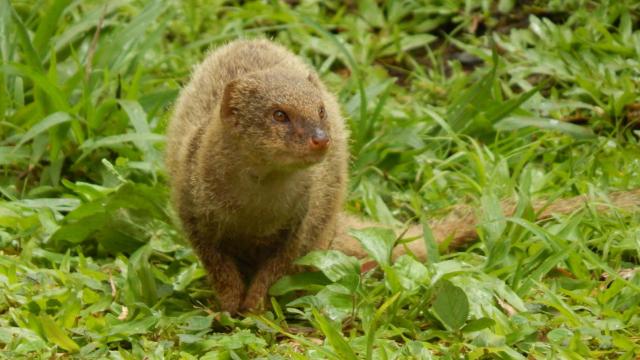Over the last 150 years, the males of certain invasive mongooses have undergone some serious tweaks to their sexual anatomy. New research suggests that the mongooses’ anal pads—which produce a scent that is apparently very alluring to female mongooses—have become comparatively shrunken, while their testicles have gotten bigger.
Island life for small Asian mongooses (Urva auropunctata) is a pretty sweet deal. Native to India and Southeast Asia, these energetic critters have been introduced (with human help) to scores of warm islands around the world, where they enjoy long lives free of predators. The mongooses tend to become explosively invasive wherever they end up, wreaking havoc on island ecosystems. But at the same time, the varmints’ repeated island colonizations serve as natural experiments in evolution.
As a PhD student at Queens College, New York, M. Aaron Owen was interested in sexual selection—how sexual preferences in one sex result in the evolution of certain characteristics in another sex—and the ongoing saga of the island mongooses seemed like a great research opportunity. Unburdened with the threat of predators, the island mongooses live in densities 66 times higher than they do in their ancestral India. The island mongoose dating scene had to be dramatically different than that of their native counterparts.
Owen—now a data scientist with Major League Baseball—started investigating these mongooses for his doctoral research. He found that little was known about the mongooses’ mating habits, other than that the males had particularly large pads encircling the anus, used in scent marking. To spare you the unforgettable visual experience of gazing upon a mongoose butthole, simply imagine a deflated and an inflated inner tube as the female and male anal pads, respectively.
The pads excrete a brown paste that Owen said doesn’t smell that strongly to humans but is thought to be quite noticeable to female mongooses.
“They’ll kind of crouch down and scoot across the substrate,” Owen told Gizmodo. “They can also be seen doing kind of a push up against a tree to get the scent as high as possible.”
Owen figured that on crowded islands, males would have less need to attract females over long distances with this aromatic butt jelly. Seeing as how mongoose females will mate with multiple males, all that extra competition might make copious sperm production more valuable. So, Owen set out to measure a bunch of mongoose testicles and anal pads.
Owen visited four different tropical islands where the mongooses had been introduced: Hawaiʻi, Mauritius, St. Croix, and Jamaica. In these places, the mongooses are captured and euthanised as a part of local eradication efforts.
“They’re honestly really cute,” said Owen. “And it’s not their fault that they’re there, but you know, they’re massive pests in most of these places. They eat basically everything. There’s no predators for them other than, you know, maybe people’s dogs.”
In India, mongooses are protected, so captured individuals were drugged so the researchers could easily take measurements of various body parts, including the testicles and anal pads.
After capturing and measuring more than 280 mongooses, the team compared male Indian mongooses with island-dwelling males. They found that the island males had bigger balls than their Indian counterparts and their anal pads were as much as a third smaller.
Their findings—published recently in the journal Evolution—reveal that generations of easy island living have resulted in rapid changes to the mongooses’ anatomy, a rare find in mammals.
“There are not many studies at all that look at rapid changes in mammal sexual traits,” said Justa Heinen-Kay, an evolutionary ecologist at the University of Minnesota who was not involved with this study.
With frequent access to mates on these densely populated islands, it appears as though the long-distance scent broadcast became less important, so the anal pads dwindled. Instead, the mongooses invested in sperm factories to meet the new challenge of competing against a torrent of other males’ sperm.
“Typically, sexual selection is thought of as males fighting with each other for access to females, or females choosing males that are displaying,” said Owen. “But, in recent years, more people are kind of looking into the role the environment and ecology is taking in the evolution of these traits.”
Heinen-Kay pointed out that the changes may be caused by phenotypic plasticity, where organisms experience certain conditions during their development that influence how their traits are produced.
“We do know that a lot of sexual traits are quite plastic, depending on conditions experienced,” she said. “But it’s still a cool result, regardless of whether it’s plasticity or evolution that’s driving it.”
Owen would be interested to know if island males with smaller anal pads or bigger balls actually end up more reproductively successful, or if introduced mongooses in islands like Japan or Fiji follow the same pattern.
“They’re on something like 70 islands around the world. So, now you can replicate your experiment over and over again,” said Owen.
